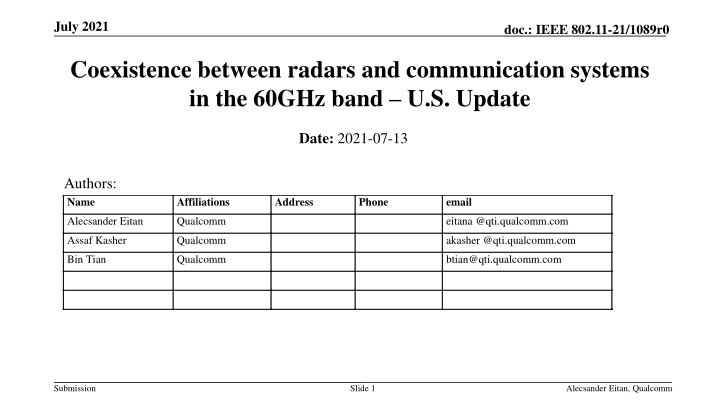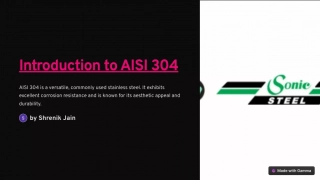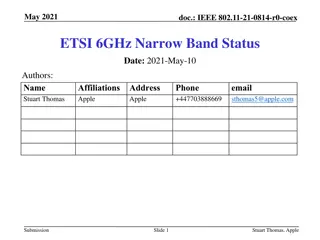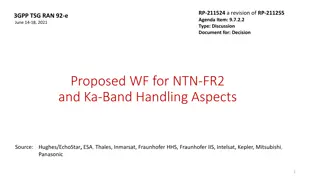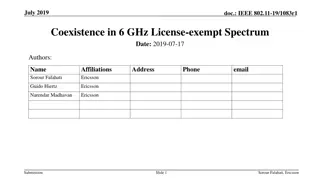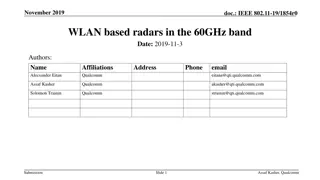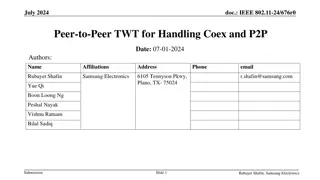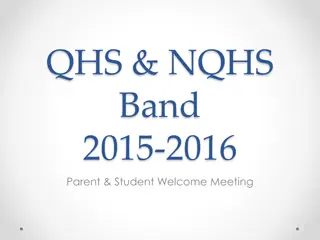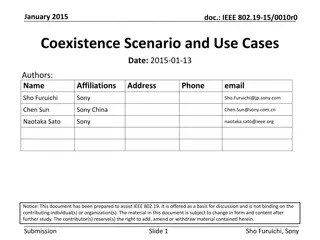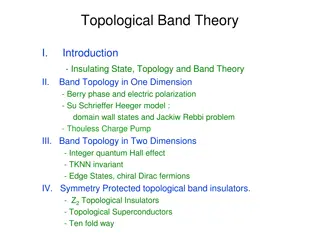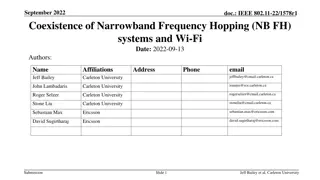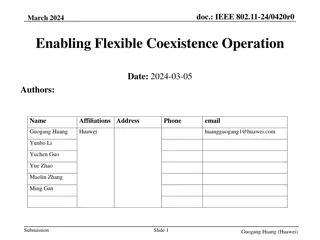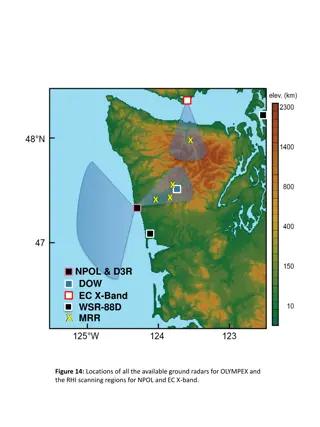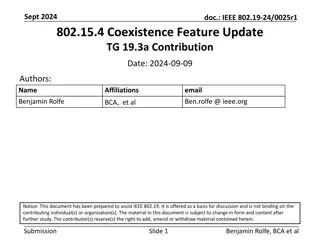Coexistence Between Radars and Communication Systems in the 60GHz Band
This document discusses the coexistence challenges and considerations between radars and communication systems operating in the 60GHz band, detailing different technologies used, access rules, regulatory discussions, and the proposed modifications by the U.S. FCC to accommodate higher power radar operations while ensuring protection for existing unlicensed communication systems.
Download Presentation

Please find below an Image/Link to download the presentation.
The content on the website is provided AS IS for your information and personal use only. It may not be sold, licensed, or shared on other websites without obtaining consent from the author.If you encounter any issues during the download, it is possible that the publisher has removed the file from their server.
You are allowed to download the files provided on this website for personal or commercial use, subject to the condition that they are used lawfully. All files are the property of their respective owners.
The content on the website is provided AS IS for your information and personal use only. It may not be sold, licensed, or shared on other websites without obtaining consent from the author.
E N D
Presentation Transcript
July 2021 doc.: IEEE 802.11-21/1089r0 Coexistence between radars and communication systems in the 60GHz band U.S. Update Date: 2021-07-13 Authors: Name Affiliations Address Phone email Alecsander Eitan Qualcomm eitana @qti.qualcomm.com Assaf Kasher Qualcomm akasher @qti.qualcomm.com Bin Tian Qualcomm btian@qti.qualcomm.com Submission Slide 1 Alecsander Eitan, Qualcomm
July 2021 doc.: IEEE 802.11-21/1089r0 Abstract This is a follow-up to our May 2021 presentation on sharing the 60 GHz band between by communication systems and radar sensing systems Each of these systems use different technologies and are subject to different access rules Coexistence among diverse uses is under discussion in several regulatory bodies and industry forums The U.S. FCC plans to adopt on July 13, 2021, a Notice of Proposed Rulemaking (in ET Docket No. 21-264) proposing modifications to its 60 GHz rules to allow higher power radar operations while maintaining appropriate protections for incumbent unlicensed communications systems Submission Slide 2 Alecsander Eitan, Qualcomm
July 2021 doc.: IEEE 802.11-21/1089r0 Communication usages in the 60 GHz band (review) Gigabit and fast WLAN access (based on IEEE 802.11ad & 11ay) Low latency applications like AR/VR (based on IEEE 802.11ad & 11ay) Gigabit backhaul, fixed wireless access indoor & outdoor (based on IEEE 802.11ay) Legacy mmWave point-to-point links (proprietary PHY & MAC) Other protocols (e.g., Wireless HDMI) and more 11ay&bf also can be used for radar/sensing function. From a coexistence point of view, 11ay&bf radar/sensing behaves exactly like an 11ad/ay communications device. Submission Slide 3 Alecsander Eitan, Qualcomm
July 2021 doc.: IEEE 802.11-21/1089r0 Radar usages in the 60 GHz band (review) Radar types include FMCW radar, pulse radars, and 11ay/11bf based radar to provide these capabilities: Gesture recognition Room sensing Car in-cabin sensing (left behind child, driver sleepiness detection) Health Application fall detection breathing/pulse tracking Wall Penetrating Radar and more Submission Slide 4 Alecsander Eitan, Qualcomm
July 2021 doc.: IEEE 802.11-21/1089r0 Communication Access (review) WLAN (11 access) LBT (listen before talk) Follow NAV rules preamble detection energy detection TDD access Scheduled Access in service periods Used in narrow beam systems Channelization 11ad/ay can set up BSS in different channels for better coexistence Submission Slide 5 Alecsander Eitan, Qualcomm
July 2021 doc.: IEEE 802.11-21/1089r0 FMCW Radar Access (review) FMCW Radar is based on transmission of sweep CW pulse. One or more pulses form a burst, and bursts are periodically transmitted Radar parameters: EIRP, sweep BW, sweep/pulse duration, number of pulses in a burst and burst period are derived from the radar requirements (max range, range resolution, max doppler, doppler resolution) and HW limitations. In general, radar transmits periodically based on operational needs There is no coordination of medium access Due to the nature of FMCW signal, FMCW radar signals self-interference is limited Submission Slide 6 Alecsander Eitan, Qualcomm
July 2021 doc.: IEEE 802.11-21/1089r0 Potential coexistence issues (review) Impact of FMCW radar on communication links Communication links can be affected by FMCW radar. Most sensitive current use case is AR/VR/XR. Large delay and delay jitter lead to negative user experience and can cause motion sickness Impact depends on FMCW operating parameters Link budget (EIRP, BW, distance, beamforming, ) Duty cycle limit definition and operational modes Activity time and pattern (e.g., burst duration and idle period between bursts) Submission Slide 7 Alecsander Eitan, Qualcomm
July 2021 doc.: IEEE 802.11-21/1089r0 U.S. FCC Draft NPRM in ET Docket No. 21-264 Draft NPRM (released June 22, 2021): 1. Proposes allowing radar/sensing devices in 57-64 GHz with 20 dBm avg EIRP, 13 dBm/MHz avg PSD, 10 dBm conducted power, and 10% duty cycle in any 33 ms interval; Seeks input on closing duty cycle loophole by requiring any off-time period between two successive radar pulses less than 2 msec to be considered on time for purposes of computing the duty cycle. 2. Proposes allowing mobile (in addition to fixed) radars in the 60 GHz band 3. In the 61.0-61.5 GHz band only, proposes permitting mobile radar/sensing devices to the same 40 dBm EIRP thas is already permitted for fixed radar/sensing devices in this 500 MHz- wide band. 4. Seeks input on permitting radar/sensing devices that use LBT, sensing, or another coexistence means to operate in entire 57-71 GHz band at the same power level (i.e., 40 dBm EIRP) communication devices are permitted to use. Submission Slide 8 Alecsander Eitan, Qualcomm
July 2021 doc.: IEEE 802.11-21/1089r0 Importance of Closing Duty Cycle Loophole To enable coexistence with 60 GHz communications devices and applications, the FCC should require any radar off-time period between two successive radar pulses that is less than 2 msec to be considered on time for purposes of computing the duty cycle This additional duty cycle condition is needed to close a loophole because FMCW radars may occupy the entire 7 GHz-wide 57-64 GHz band and continuously block/impact nearby 11ad/ay systems even with a 10% duty cycle by using a very short pulse. For example, FMCW radars may transmit for 10 s followed by 90 s of off time, but the 90 s of off time is too short for nearby 11ad/ay system to effectively utilize the channel. An FMCW radar thus can occupy the entire 7 GHz-wide band and continuously block/impact nearby 11ad/ay systems. Additional duty cycle limitation is needed to ensure that this does not occur. Also, a long transmission time of 3.3 msec also can impact the ability of other systems to access the channel and may impact latency (e.g., AR/VR) Recent FCC waivers include the 2 msec loophole closing condition. See, e.g., DA-21-811A1.pdf DA-21-812A1.pdf DA-21-813A1.pdf Submission Slide 9 Alecsander Eitan, Qualcomm
July 2021 doc.: IEEE 802.11-21/1089r0 U.S. FCC NPRM in ET Docket No. 21-264 Final NPRM to be released in mid-July following its approval by the FCC on July 13, 2021 The Final NPRM may include non-material modifications to the draft NPRM based on inputs to the FCC since its release of the Draft NPRM We are available to answer any questions or help any IEEE members provide comments to the FCC on the 60 GHz NPRM Comments and Reply Comments likely will be due in September and October 2021 timeframe, 30 days and 60 days after the NPRM is published in the U.S. Federal Register Submission Slide 10 Alecsander Eitan, Qualcomm
July 2021 doc.: IEEE 802.11-21/1089r0 Summary There are coexistence issues in the 60 GHz band between FMCW (and other, e.g., pulsed) radars and WLAN communications (11ad/ay), especially for low latency applications The U.S. FCC plans to adopt on July 13, 2021, a Notice of Proposed Rulemaking (in ET Docket No. 21-264) proposing modifications to its 60 GHz rules to allow higher power radar operations while maintaining appropriate protections for incumbent unlicensed communications systems IEEE community should respond to NPRM and promote rules to ensure improved coexistence between communications and radar devices Submission Slide 11 Alecsander Eitan, Qualcomm
